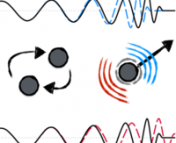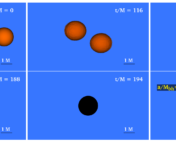Title: Candidate Electromagnetic Counterpart to the Binary Black Hole Merger Gravitational-Wave Event S190521g
Authors: M. J. Graham, K. E. S. Ford, B. McKernan et al.
First Author’s Institution: California Institute of Technology
Status: Published in Physical Review Letters [closed access]
When two dense bodies such as black holes or neutron stars collide, they emit gravitational waves. For neutron stars in particular, the gravitational waves can be accompanied by radiation coming from material ejected during the merger. By contrast, as neither light nor material can escape black holes, we do not expect merging black holes to emit radiation. However, today’s paper reports that if the conditions are just right, a black hole merger can also emit light.
But how can black holes emit light?
Clickbait alert! The light does not originate from the black holes, but from surrounding material. When two black holes of unequal masses merge, the resulting gravitational waves carry momentum away from the system. In order to conserve linear momentum, the newly formed black hole experiences a recoil “kick” accelerating it to high velocities (around 200 km/s). If the black hole is surrounded by large amounts of gas, it heats up this gas as it speeds through it. This hot, shocked gas can then radiate light for up to three months after the black hole passes through it.
Where can we find “bright” black hole mergers?
Active galaxies are special galaxies that host supermassive black holes at their centers. These centers are called active galactic nuclei (AGN), and are ideal places for such mergers to occur. The supermassive black holes in AGN collect (or, more technically, accrete) massive amounts of surrounding material onto themselves. This forms a large, dense accretion disk around the supermassive black hole. The radius of this disk is around 0.01 parsec – in more intuitive terms, about one thousand times the distance between the Earth and the Sun. This disk contains a large amount of gas and dust, as well as stars and even black holes. If two black holes merge within this disk, we expect to see light from the merger through the process described above. The emission is expected to start a few weeks after the merger and last for about three months. This scenario is illustrated in Figure 1.
Sleuthing for bright black hole mergers
The authors of today’s paper decided to hunt for such emission from AGN. They focused on all black hole mergers that were detected by LIGO during O3a – an observing run between April-September 2019. For each merger, they identified galaxies from an AGN catalog that were consistent with the position of the merger as reported by LIGO. They then used data from the Zwicky Transient Facility (ZTF) – an optical telescope that monitors the full northern sky every night – to see if the brightness of any of these AGN increased dramatically during this time. And voilà! They found an AGN, J124942.3+344929, that brightened just 34 days after LIGO detected the black hole merger S190521g. This flare in brightness lasted for 80 days after which it returned to its initial brightness – a behaviour that is expected for black hole merger flares. This is shown in Figure 2, which depicts the light curve (brightness vs time) of this AGN.
Are we absolutely sure that this flaring is due to a black hole merger?
Well, not really. AGN are known to show intrinsic random fluctuations in their brightness, e.g. when the central black hole swallows surrounding material. The authors conduct a statistical analysis to show that the chance of the observed flare being the result of a random variation in the AGN is smaller than 5 in a million. It is also possible that this flare could be due to something like a supernova explosion in the AGN disk. However, such explosions become colder with time, causing their observed colour to become redder (recall blackbody physics – a cold object appears redder than a hot object because most of its light is concentrated at longer wavelengths ). The observed flare, however, stayed at roughly the same colour (as seen in panel 3 of Figure 2) suggesting that the temperature remained constant, ruling out a possible supernova origin . Thus, although the true nature of this flare still remains a mystery, it is likely that it was caused by two black holes crashing into each other.
The authors note that early spectroscopic observations of this event could have provided an additional thread of evidence about the true nature of this flare. They also predict that if the black hole merger hypothesis is true, the kicked black hole will collide with the AGN disk again in ~1.6 years causing a similar flare in the AGN. They will keep their eyes (and telescopes) peeled to see if their prediction comes true! If their hypothesis is correct, astronomers will have a new tool to study the physics of black holes and AGN disks. More importantly, it will provide us with an extremely wholesome experience – “seeing” a couple of black holes hug each other!
Astrobite edited by Graham Doskoch, Sunayana Bhargava
Featured image credit: Caltech/R. Hurt (IPAC)




